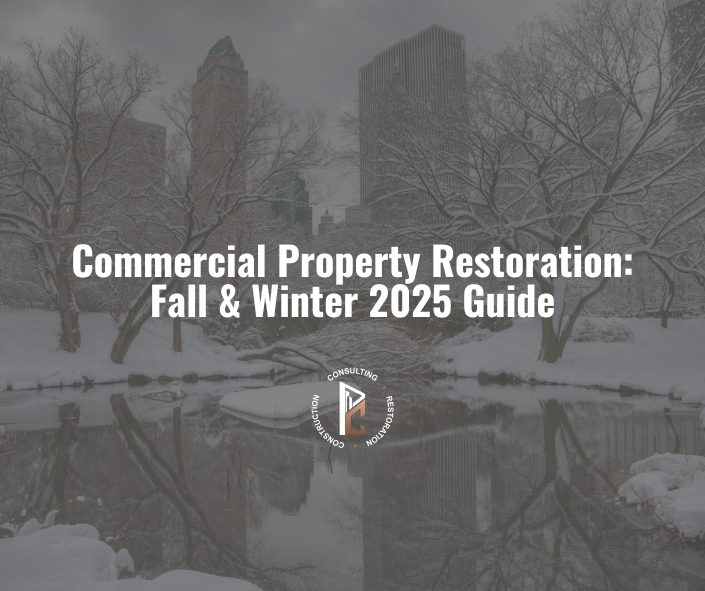
Protecting Your Commercial Property: Essential Fall & Winter Restoration Insights for 2025
As we move deeper into fall 2025, commercial property owners face a critical period of heightened risk. With the restoration industry projected to surpass $4 billion this year and global insured losses from natural disasters expected to reach $145 billion by year’s end, understanding property damage prevention and emergency response has never been more important.
The Current State of Commercial Property Risks
The commercial property insurance landscape in 2025 is navigating unprecedented challenges. Rising repair costs, persistent labor shortages, and increasingly severe weather events are converging to create a perfect storm for property owners. Recent data shows that insurance restoration contractors experienced modest growth of just 2.7% last year, but industry experts anticipate significant increases in demand for comprehensive restoration services throughout 2025.
Key Industry Trends Shaping 2025
Technology’s Growing Impact
For the first time in years, technology—not labor shortages—is emerging as the top trend affecting the restoration industry. AI adoption and advanced property claims management systems are fundamentally changing how restoration providers and insurance companies collaborate to improve property damage recovery.
Climate-Driven Challenges
Multiple converging forces from climate change are creating major disruptions in property claims management. The National Weather Service issued more than 3,600 flash flood warnings across the United States in just the first eight months of 2025, highlighting the increasing frequency of water-related incidents.
Seasonal Risks: What Fall and Winter Bring
Autumn Hazards
Fall’s unpredictable weather exacerbates numerous property risks:
- Water Damage: Heavy rainfall and clogged drainage systems from fallen leaves can lead to roof damage and water intrusion
- Slip and Fall Hazards: Wet leaves and shorter daylight hours increase liability risks around commercial properties
- Storm Damage: Hurricane season peaks between August and October, with severe storms capable of causing extensive property damage
Winter Threats
As temperatures drop, commercial properties face additional challenges:
- Frozen Pipes: One of the most common and costly winter property damage issues
- Ice Dams: Can cause significant roof damage and interior water intrusion
- Heating System Failures: Can lead to frozen equipment and business disruptions
- Power Outages: Winter storms can cause extended outages affecting operations
- Building Structural Stress: Snow accumulation and ice can strain roofing systems
Emergency Response Best Practices
When property damage occurs, having a comprehensive emergency response plan is essential. The four critical components of an effective emergency response plan are:
1. Mitigation
Proactive measures to reduce potential damage before incidents occur. This includes:
- Regular property inspections each season
- Identifying and documenting potential hazards
- Maintaining heating systems and insulation
- Clearing gutters and drainage systems
2. Preparedness
Establishing protocols and resources before emergencies strike:
- Designate emergency contacts and restoration providers
- Create evacuation routes and safety procedures
- Maintain updated property insurance documentation
- Establish communication protocols for tenants and employees
3. Response
Immediate actions when damage occurs:
- Ensure everyone’s safety and evacuate if necessary
- Inspect property for visible damage
- Contact insurance providers promptly
- Engage certified restoration professionals immediately
- Document all damage with photos and detailed notes
4. Recovery
Systematic restoration to return to normal operations:
- Remove debris and damaged materials
- Restore essential systems (power, plumbing, HVAC)
- Work with restoration professionals for major repairs
- Minimize business downtime through phased restoration
- Maintain communication with all stakeholders
The Insurance Claims Process: What You Need to Know
Understanding how restoration companies handle insurance claims can significantly streamline your recovery process. Professional restoration teams provide:
- Initial Damage Assessment: Comprehensive evaluation of all affected areas
- Detailed Estimating: Accurate cost projections using industry-standard software
- Documentation: Drying logs, environmental reports, and photographic evidence
- Ongoing Communication: Regular updates to insurance adjusters and property owners
- Compliance: Adherence to all insurance requirements and industry standards
Recent carrier coverage changes continue to impact the restoration industry, making it crucial to work with experienced restoration contractors who understand current insurance landscapes and can navigate complex claims processes.
Proactive Steps for Commercial Property Owners
Immediate Actions for Fall 2025
- Conduct Property Walkthroughs: Identify potential hazards before they become problems
- Review Insurance Coverage: Ensure policies adequately cover seasonal risks
- Inspect Roofing Systems: Check for damage and clear debris
- Test Heating Systems: Verify proper operation before winter arrives
- Insulate Vulnerable Pipes: Prevent costly freeze damage
- Establish Restoration Partnerships: Don’t wait for emergencies to find qualified contractors
Long-Term Risk Management
- Develop Comprehensive Emergency Management Plans: Every commercial property needs documented procedures for various disaster scenarios
- Invest in Preventative Maintenance: Regular inspections and maintenance significantly reduce emergency incidents
- Train Staff: Ensure employees understand emergency protocols and evacuation procedures
- Leverage Technology: Consider advanced monitoring systems for early detection of water leaks, temperature fluctuations, and other issues
The Value of Professional Restoration Services
Commercial restoration services play an essential role in expediting recovery processes and minimizing business downtime. Professional restoration providers offer:
- 24/7 Emergency Response: Immediate action to prevent further damage
- Certified Technicians: Properly trained personnel with appropriate equipment
- Advanced Technology: State-of-the-art drying, cleaning, and restoration equipment
- Insurance Expertise: Streamlined claims processing and documentation
- Comprehensive Services: From initial emergency response through complete restoration
Working with established restoration companies allows businesses to deploy certified technicians with proper equipment and training, ensuring faster recovery and reduced operational disruption.
Looking Ahead: Preparing for 2025’s Challenges
Industry experts anticipate continued optimism in the restoration sector, with expected increases in demand for comprehensive restoration services. However, this optimism must be balanced with realistic preparation for:
- Rising Repair Costs: Inflation continues to impact restoration expenses
- Labor Market Challenges: While improving, skilled labor remains in demand
- Increased Weather Severity: Climate patterns suggest more frequent severe events
- Evolving Insurance Requirements: Carriers continue adjusting coverage terms
Conclusion: Protection Through Preparation
The fall and winter months of 2025 present significant challenges for commercial property owners, but these risks can be effectively managed through proactive planning, comprehensive emergency response protocols, and partnerships with qualified restoration professionals.
By understanding current industry trends, recognizing seasonal hazards, and implementing best practices for emergency preparedness, commercial property owners can protect their investments, minimize business disruptions, and ensure rapid recovery when incidents occur.
Don’t wait for disaster to strike. Take action now to assess your property’s vulnerabilities, review your insurance coverage, and establish relationships with certified restoration providers. The investment in preparation today can save thousands in damages and lost revenue tomorrow.

